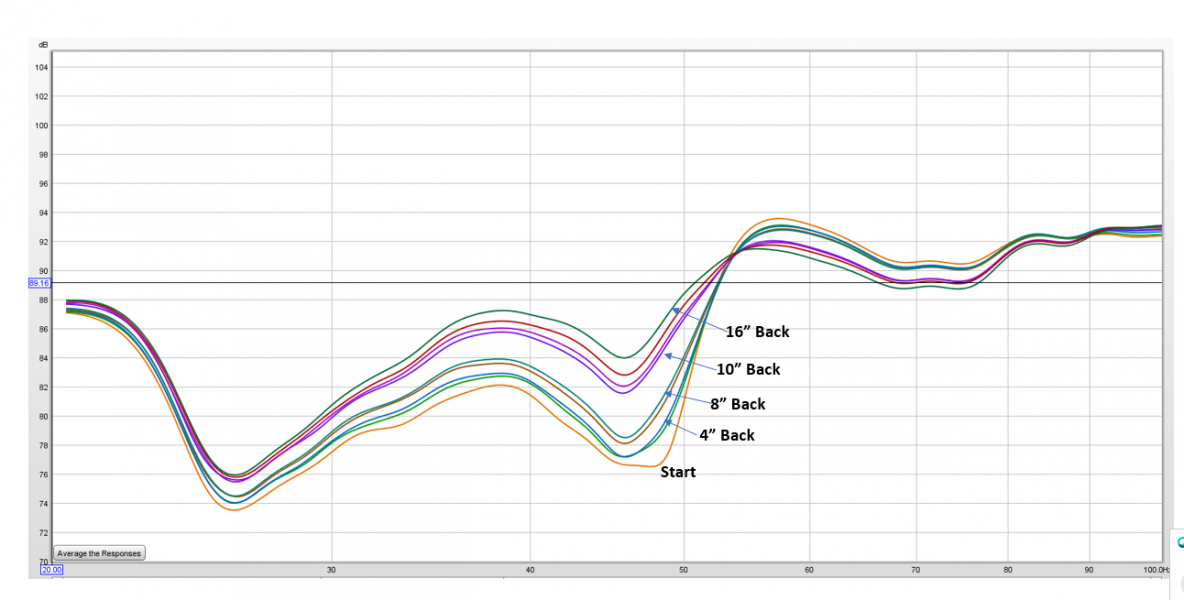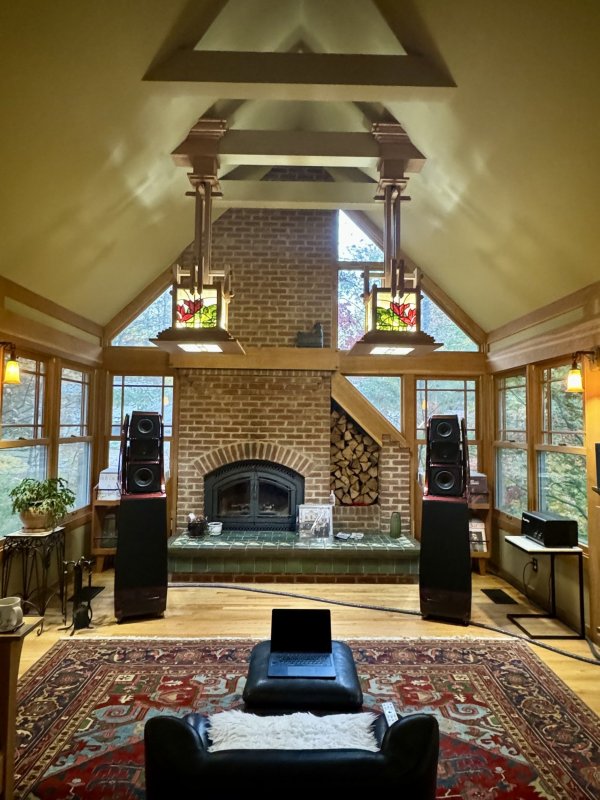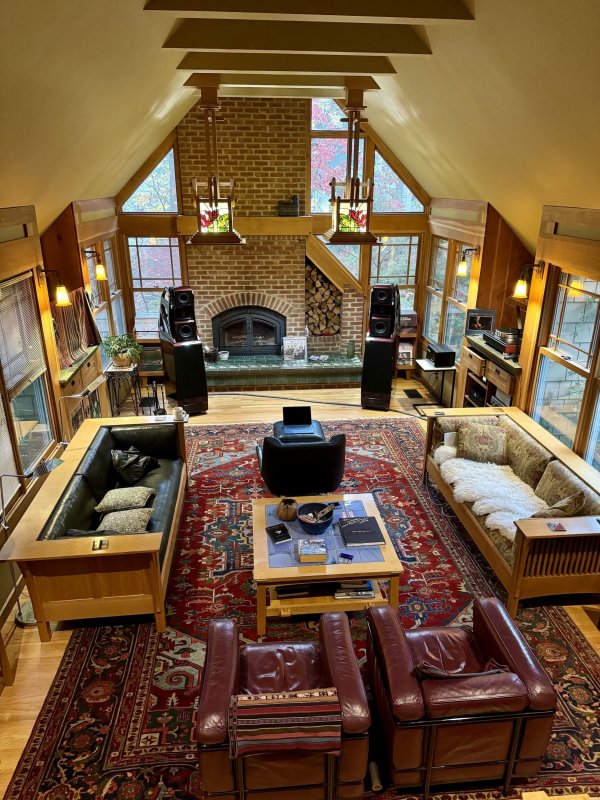That's exactly the plan. However I do have a foot or so flexibility in the seating position. My primary problem (IMO) is soundstage depth. The solution as I understand it is to pull the speakers off the front wall more (currently at 4'9"). Tow in is the other factor that I'm playing with. Each move I'm making is followed by several days of listening as Mike suggested. It's great to be retired!As your room is large enough to allow you to avoid the usual compromises in the bass, why not define the listening position first and optimise speaker positioning based on that?
Is there only one best location in a room for a set of speakers?
- Thread starter ScottK
- Start date
You are using an out of date browser. It may not display this or other websites correctly.
You should upgrade or use an alternative browser.
You should upgrade or use an alternative browser.
Interesting thread. I read through it but did not see anyone mention what constitutes "best". I see comments that this is subjective and up to the listener. However, I think we would all agree on a few criteria that need to be met for "best" to apply.
that a smooth bass response is preferred to a lumpy one.
that boomy and or muddy bass is bad
that we want the sound between the bass, midrange and treble to blend together.
that we want an atriculate midrange. not sounding too thin or too thick.
that we want nice, extended treble without sibilance or harshness
Do we all agree that those would be "best" to have? If so then I believe that out of the infinite possible locations there exists a very small subset that works to even get close to "best".
Everyone has constraints on where they can sit or where the speakers can live. We have to work within those boundaries which can compromise the best possible performance. We can find a spot that is locally best (to borrow terminology from mathematics). If someone has the whole room to explore then a "best" is possible.
How to find it is the trick. Here is one idea to explore. Take Wilson's zone of neutrality for example. They always find this zone in the front of the room walking away from the walls. This makes perfect sense from a dealer perspective (and 90% of everybody perspective) as this is where the speakers need to live. Most can't pull speaker 10' or more from the front wall. However, there is more than one zone of neutrality in a room. You can try this. Find the borders of the first zone. Then keep walking and talking and you will find another spot where your voice sounds natrual again. You can mark this area. Depending on your room and speaker the second or thrid zone may sound much better.
JS's idea of finding the optimum listening spot first is a great one. It almost guarentee's smooth bass response regardless of where the speaker goes.
I agree with Mike's comment that things in our system change. So the best spot is going to change. To me this simply means the speakers optimum position has changed slightly and needs to be adjusted. I realize this is somewhat contentious. There was a whole thread that blew up because of it. It is not very convenient to think about so it is much easier to ignore it and move on. But we are looking for "best".
Regardless if there is one, two or three best locations finding them is going to take substantial work.
that a smooth bass response is preferred to a lumpy one.
that boomy and or muddy bass is bad
that we want the sound between the bass, midrange and treble to blend together.
that we want an atriculate midrange. not sounding too thin or too thick.
that we want nice, extended treble without sibilance or harshness
Do we all agree that those would be "best" to have? If so then I believe that out of the infinite possible locations there exists a very small subset that works to even get close to "best".
Everyone has constraints on where they can sit or where the speakers can live. We have to work within those boundaries which can compromise the best possible performance. We can find a spot that is locally best (to borrow terminology from mathematics). If someone has the whole room to explore then a "best" is possible.
How to find it is the trick. Here is one idea to explore. Take Wilson's zone of neutrality for example. They always find this zone in the front of the room walking away from the walls. This makes perfect sense from a dealer perspective (and 90% of everybody perspective) as this is where the speakers need to live. Most can't pull speaker 10' or more from the front wall. However, there is more than one zone of neutrality in a room. You can try this. Find the borders of the first zone. Then keep walking and talking and you will find another spot where your voice sounds natrual again. You can mark this area. Depending on your room and speaker the second or thrid zone may sound much better.
JS's idea of finding the optimum listening spot first is a great one. It almost guarentee's smooth bass response regardless of where the speaker goes.
I agree with Mike's comment that things in our system change. So the best spot is going to change. To me this simply means the speakers optimum position has changed slightly and needs to be adjusted. I realize this is somewhat contentious. There was a whole thread that blew up because of it. It is not very convenient to think about so it is much easier to ignore it and move on. But we are looking for "best".
Regardless if there is one, two or three best locations finding them is going to take substantial work.
Hello Scott,That's exactly the plan. However I do have a foot or so flexibility in the seating position. My primary problem (IMO) is soundstage depth. The solution as I understand it is to pull the speakers off the front wall more (currently at 4'9"). Tow in is the other factor that I'm playing with. Each move I'm making is followed by several days of listening as Mike suggested. It's great to be retired!
A lot can happen in a foot. I would explore if you can smooth out the bass any by moving the chair forward/backward. JS would use an RTA for this. Within 12" I would simply take 12 measurements spaced one inch apart and pick the best one. I will find an REW plot that illustrates this and post it.
These are all great descriptors and for the most part I'm happy with these criteria. As I mentioned it's soundstage that I'm obsessing over particularly depth.that a smooth bass response is preferred to a lumpy one.
that boomy and or muddy bass is bad
that we want the sound between the bass, midrange and treble to blend together.
that we want an atriculate midrange. not sounding too thin or too thick.
that we want nice, extended treble without sibilance or harshness
These are all great descriptors and for the most part I'm happy with these criteria. As I mentioned it's soundstage that I'm obsessing over particularly depth.
Do you have the rack in the middle or at the side
@ScottK , Here is a set of frequency repsonse curves that I took with my former speakers. I moved the sofa in 2" increments. THis is a good example as you can see something snapped at the 10" mark. (This is smoothed to 1/24 Octave). You can see how much things can change with in a foot.


Agree with this. Having large, tall objects between the speakers will inhibit imaging and soundstage.Do you have the rack in the middle or at the side
Hello ScottThese are all great descriptors and for the most part I'm happy with these criteria. As I mentioned it's soundstage that I'm obsessing over particularly depth.
WRT Soundstage depth you try moving closer??
Rob
...or in this case, a million words and maybe a bottle of Scotch. Nice looking room.Picture is worth a thousand words!
That's not fair....that always works!maybe a bottle of Scotch
May I respectfully disagree -- and agree with Mike -- for the reasons Mike detailed above plus one: as your seating position varies, so will the optimum speaker placement.
As your room is large enough to allow you to avoid the usual compromises in the bass, why not define the listening position first and optimise speaker positioning based on that?
In theory, there should be one ideal placement for the speakers, all other things being equal (temperature, dB SPL, power, etc, etc, too many variables to enumerate!). Regards
Of course you can disagree. But I think most who feel differently likely have not heard an optimized setup.
As for bass, as we noted here several times and in the video I did, the chair is optimized first for bass response using RTA.
Such a cool room!Picture is worth a thousand words!
You’ve seen Jim Smith’s name on this thread and for good reason; he’s a setup guru and author of, IMHO, a must-have book: Get Better Sound. There are hundreds of setup tips, including many that address speaker placement and listening position.
I’ve listened in an equilateral triangle since getting my current speakers several years ago and felt my positioning was “perfect” for the room. But I recently revisited Jim’s book, in which he writes about “hifi” vs. “musical” sound. He makes the point that certain setups give pinpoint imaging and lots of room around instruments, which is technically impressive but for some people (himself included) doesn’t draw him into the music. He much prefers the 83% rule. Tweeter to tweeter distance is 83% of the tweeter to ear distance. I’ve avoided this in the past because I felt I might be too close to my back wall, but I tried it anyway (why not: it’s free, with no obligation!) and although I lost some hifi, the presentation smoothed out and was very easy and enjoyable to listen to. It focuses you on the music, not on the sound. So, as you alluded to, there is no “perfect” position because everyone hears differently and values different aspects of the soundscape.
Which brings me to my final comment. Just because the Jim Smiths of the world may think they’ve found the “perfect” spot for your speakers doesn’t mean it’s the perfect spot for you. He makes that point. So figure out what sound you are trying to achieve and that will largely determine the “perfect” spot for you.
I’ve listened in an equilateral triangle since getting my current speakers several years ago and felt my positioning was “perfect” for the room. But I recently revisited Jim’s book, in which he writes about “hifi” vs. “musical” sound. He makes the point that certain setups give pinpoint imaging and lots of room around instruments, which is technically impressive but for some people (himself included) doesn’t draw him into the music. He much prefers the 83% rule. Tweeter to tweeter distance is 83% of the tweeter to ear distance. I’ve avoided this in the past because I felt I might be too close to my back wall, but I tried it anyway (why not: it’s free, with no obligation!) and although I lost some hifi, the presentation smoothed out and was very easy and enjoyable to listen to. It focuses you on the music, not on the sound. So, as you alluded to, there is no “perfect” position because everyone hears differently and values different aspects of the soundscape.
Which brings me to my final comment. Just because the Jim Smiths of the world may think they’ve found the “perfect” spot for your speakers doesn’t mean it’s the perfect spot for you. He makes that point. So figure out what sound you are trying to achieve and that will largely determine the “perfect” spot for you.
I'm at 83% and totally agree with this. Your observation about HiFI vs Musicality is spot on.Which brings me to my final comment. Just because the Jim Smiths of the world may think they’ve found the “perfect” spot for your speakers doesn’t mean it’s the perfect spot for you. He makes that point. So figure out what sound you are trying to achieve and that will largely determine the “perfect” spot for you.
Awesome room; digging on it!Picture is worth a thousand words!
I don't know a lot about room setup. But I have been exposed to quite a few systems. It seems to me there are options on how to setup a room. Especially if the room is large enough to allow for near and far listening. That creates a radically different type of listening session. I sometimes gravitate to one of the other in my room. But for the most part am near as I listen in the 60 DB peak range. When I start playing into the 70 and very low 80s, I push back to a little. The back of my room is open too. A good 40 feet of depth.
Generally my speakers are about 40 inches face to front wall. Works great for near and medium. If I really want far listening, they can move out 5 to 7 feet. Even further.
Generally my speakers are about 40 inches face to front wall. Works great for near and medium. If I really want far listening, they can move out 5 to 7 feet. Even further.
Beautiful room and setup. How do you find the windows/glass impact the music?Picture is worth a thousand words!
I'm sure the sound would be different if I had no windows but I can't hear any adverse impact. If you look at the point of first reflection the tweeters hit an alcove in the wall that effectively disperses those frequencies. I have purposefully put record racks in the corners in the front wall to act as bass traps.How do you find the windows/glass impact the music?
Republicoftexas69
Well-Known Member
Scott, lovely room. This is why I chose a smaller room in my house, easier to control so to speak. Will be moving to a larger room on the second floor of my home once I am sure I do not have any boomerang kids. Bigger room bigger challenges. Love your setup.I'm sure the sound would be different if I had no windows but I can't hear any adverse impact. If you look at the point of first reflection the tweeters hit an alcove in the wall that effectively disperses those frequencies. I have purposefully put record racks in the corners in the front wall to act as bass traps.
Similar threads
- Replies
- 48
- Views
- 4K
- Replies
- 99
- Views
- 11K
- Replies
- 108
- Views
- 8K
- Replies
- 0
- Views
- 1K
| Steve Williams Site Founder | Site Owner | Administrator | Ron Resnick Site Owner | Administrator | Julian (The Fixer) Website Build | Marketing Managersing |








